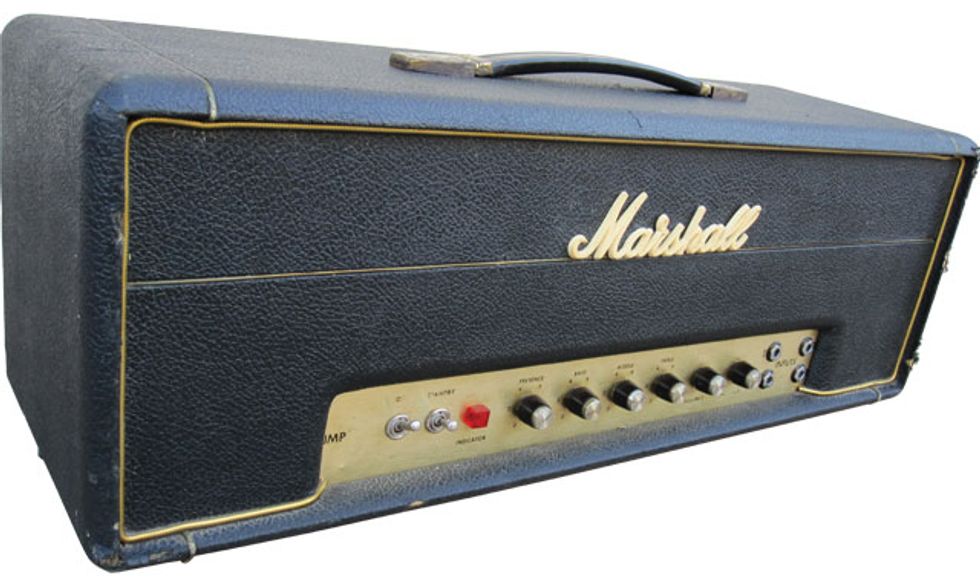With today’s amps all sounding so different, finding your tone (and a tone that works within the context of a band) can be challenging. A tone that sounds great on its own can tend to disappear once the rest of the band kicks in. With the advent of digital modeling and amps with so many bells and whistles, it’s very easy to get caught up in modern tech and lose focus on the music. My signature CAA PT100 amp, which we looked at in last month’s column [“Base Tones,” August 2013], is a multi-channel affair that offers many very cool features. It sounds fantastic, offers the versatility I need, and I wouldn’t want it any other way. But sometimes—especially in the studio—I like to get back to basics and use amps that are as simple and stripped down as possible.
Around 1996, I was recording an album with my band Surreal McCoys. We’d been signed to Sony in Japan and were making the album for the Japanese and Southeast Asian markets. We had a pretty good budget to work with, so we bought a few cool amps and brought the other amps and guitars we already owned into the studio. I was mainly using an amp that was very popular at the time (name withheld to protect the innocent), and it sounded really good to me in the room, especially at low volumes. Someone even observed that the sound coming out of the cabinet seemed polished and perfect, like a guitar sound that was already recorded and mastered. I remember thinking that was a great description of the tone.
The other guitarist in the band was Frank Simes, a veteran sideman and session player who’s toured and recorded with Mick Jagger, Stevie Nicks, Don Henley, and others. Frank is a terrific guitarist with a great ear for tone and one of the amps he brought into the studio was a 100-watt, 1967 Marshall Super Lead. These heads are legendary for their stellar rock tone and have been used by everyone from Jimi Hendrix to Eddie Van Halen. They’re simple, no-frills amps that you have to really turn up in order to get them to overdrive. The guitar can become a wild beast in your hands with this kind of volume, but in the hands of a gifted player like Frank, these amps can sound fantastic.
When we were setting up to do guitars in the studio, we were able to directly compare all the amps we’d assembled against one another. When we listened to my amp against Frank’s Super Lead, there was a huge difference—especially when mic’d up and listening through studio monitors. The Marshall had presence, personality, and was a bit out-of-control sounding in a great way. Though it could seem excessively bright, brash, and hard to tame while standing in a room right next to it, the tone fit in a mix with bass and drums beautifully by delivering the definitive sound of rock ’n’ roll.
In contrast, the polished quality that my amp exhibited tended to make parts sound somewhat tame and rather dark. It was almost like the sound wasn’t projecting when compared to the Marshall, as if the sound was stuck in the cabinet. It simply lacked personality. That polished quality seemed more like a deficit than an asset and I learned a couple of important lessons that day.
The first is that when you stick a microphone in front of a cabinet and slot a guitar tone in a mix with thundering bass and sizzling cymbals, you have to make sure the tone occupies a sonic space not taken up by the other instruments. The guitar lives and breathes in the midrange and an amp with healthy mids and upper mids will help your tone cut through the mix. I also learned that even if a tone is wild and sounds a bit out-of-control, it could sound just right once filtered through a microphone and dropped into a mix with other instruments. Some of the greatest guitar parts ever recorded feature tones that may sound downright unpleasant when heard on their own!
Another thing I’ve noticed about non-master-volume, vintage-style amps is they tend to really enhance the personality and individuality of each player. It seems that the simpler the design, the more the player and other components like the guitar, pickups, and effects shine through in the tone. When we think of all the legends like Jimi Hendrix, Angus Young, Eddie Van Halen, and Eric Clapton who famously used early Marshall amps, the amazing thing is the amount of tonal variation between each player.
Contrast this with the ’90s, when the Mesa/Boogie Dual Rectifier became the popular choice with the nu-metal crowd. The Rectifier is a modern classic for sure, great at what it does, and I’ve owned more than one. But it could be argued that many guitarists that used and still use them sound somewhat similar. Food for thought, but I think this is a fairly common trait of amps that have multiple gain stages and form much of their tone in the preamp.
All said, it’s a great time to be a guitarist because there’s an incredible variety of gear out there to help us achieve great tones. Modern amps and digital modelers can sound fantastic and fit the bill nicely in many musical situations. Indeed, my signature PT100 amp is my absolute main squeeze these days and it always provides me with incredibly inspiring tones. We’ve gone to great lengths with the PT100 to make sure it’s got loads of character like the best vintage amps. But sometimes—especially in the studio—there’s nothing like plugging into a simple, non-master-volume amp and just cranking it up. It’s arguably the most fun you can have while still wearing pants!
Until next time, I wish you much success on the path to great tone.











![Rig Rundown: Russian Circles’ Mike Sullivan [2025]](https://www.premierguitar.com/media-library/youtube.jpg?id=62303631&width=1245&height=700&quality=70&coordinates=0%2C0%2C0%2C0)







